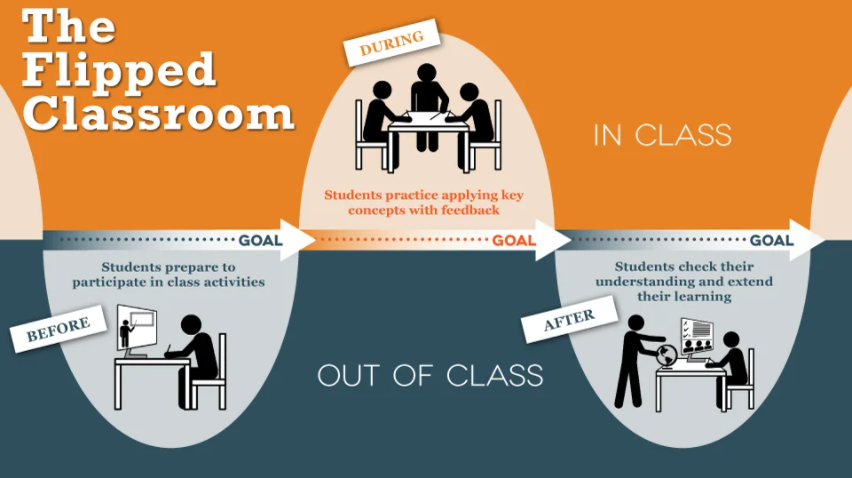~ Saakshi Sharma
Jonathan_Bergmann and Aaron_Sams, two high school teachers from Colorado, are credited with the creation of what is called the ‘flipped’ or ‘inverted’ classroom. Flipped Classroom Approach as the name suggests ‘flips’ the traditional teaching methods used inside the classroom. It completely departs away from the traditional approach of making students learn. Flipped Classroom Approach is a type of blended learning. In this, unlike the traditional approach, a student needs to watch lectures online at home while solving problems, doing assignments and projects in the class. A student has access to the content and topic to be taught before the class through online study. In the class, a student needs to apply his/her understanding and knowledge about various concepts and facts. All the homework is to be done in the class itself. The student-teacher interaction increases. The student instead of being a mere listener engages more in discussions. With assignments, projects and experiments being done in class, it becomes more of practical learning.
The Pros
More Interactive Classes
The classes are more student-centric. There is increased communication and interaction between students and teachers. The teacher can pay attention to each student. And also keep a check on what all they are learning more easily. Solving problems and questions in the class under the guidance of a teacher helps in better conceptual understanding. It also facilitates instant doubt-clearance.
Better Student Management
The students who cannot grasp things easily are benefited a lot from this method. They can watch the lectures as many times as they want to. They can take notes more easily of the points. They can rewind and watch any part any time they want to. Students can watch the video as and when they want. A study done on 9th-12th graders observed that on average the students spent 38 hours per week doing homework! With flipped classroom approach, this work is completed by students in the class only. They get enough time to self-study at home and engage in other stuff as well. It helps them manage their studies as well as other activities more efficiently.
Easy Access To Content
The content is easily accessible to the students. They don’t need to worry even if they have to miss any lecture. It’s available for them 24×7! They can watch the recorded lecture any time and cover up all the topics missed.
Parents Be Updated
The parents often complain about not knowing what’s going inside the classroom. The inclusion of online education helps parents analyse the performance of the child better. They also have access to the study material. It creates more transparency for parents. Thus, it helps the parents to be more updated.
The Cons
Digital Gap
One of the most important things to access the lectures is having a phone or computer and internet. The students belonging to low-income families or ones who do not have the necessary equipment to function face certain issues. Having limited access to technology keeps them at a disadvantage.
Increased Workload On The Teacher
The teacher not only needs to explain everything but they are required to make presentations also. They need to do extra work like editing and uploading the videos. This requires time as well as skill. The teachers have to be sure that all the important elements regarding the lecture are included and integrated well enough for the students to understand. This can be in a way challenging for the teachers who are not much experienced or adapted to online teaching.
Assumption That Students Are Prepared
Some students won’t watch the content required to attend the class the next day. They would either skip it, delay it or watch it in parts. This hinders the understanding and development of skills and concepts. The teacher when in class has to assume that the students have completed what they were supposed to proceed further. The students can not be obliged to do so in any way.
Increased Use Of Technological Devices
The increased use of phones, computers or laptops can affect the students’ physical, mental and visual health. The increased and constant use of gadgets and screens can lead not only to weak eyesight, frequent headaches, sleep disorders and shortness of temper but also to serious diseases such as cancer and brain tumours.
Conclusion
The flipped classroom approach is an engaging, exciting and interesting model to adapt. A study was conducted at Columbia University’s Mailman School of Public Health. In it, there was an analysis of the traditional model of education versus flipped classroom approach. The results showed that flipped methods allowed for more flexible and applied learning opportunities. Despite the challenges to the flipped classroom model, the unique, innovative, practical and intriguing approach of the model cannot be denied.
Must Read: https://skchildrenfoundation.org/how-is-playing-by-learning-better-than-theoretical-learning/






2 Responses
👍👍
Hi Vedanti, Thank you very much for going through our blogs. It’s a pleasure to give voice to the facts and opinions for you all to read. Keep encouraging us by staying tuned to our posts and with your lovely comments.
Thanks a lot!